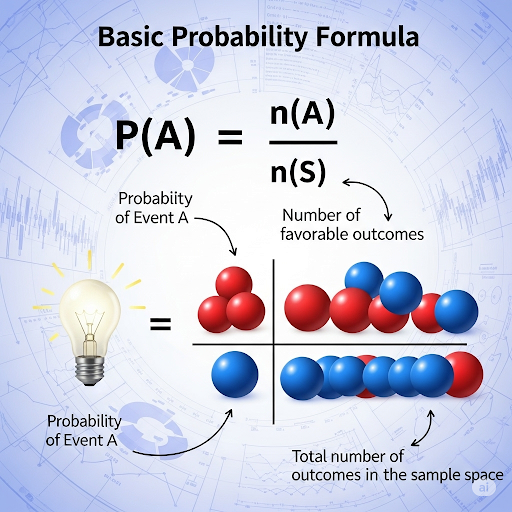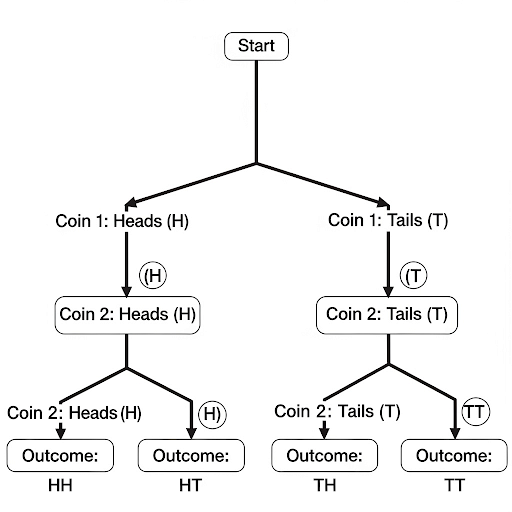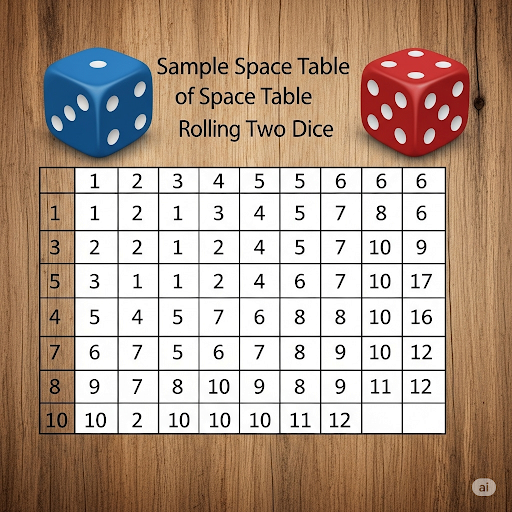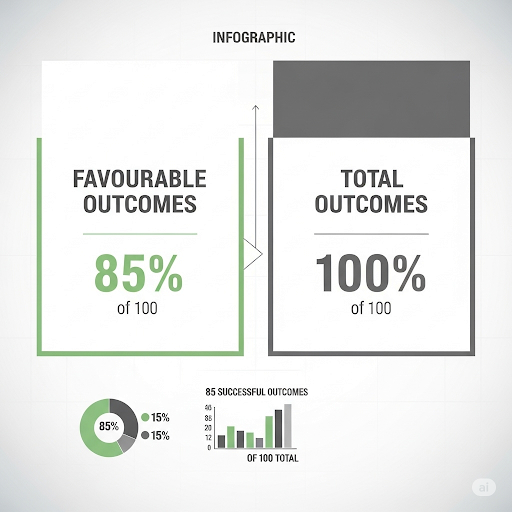Professional Courses
Industry-relevant training in Business, Technology, and Design to help professionals and graduates upskill for real-world careers.
Categories
Interactive Games
Fun, engaging games to boost memory, math fluency, typing speed, and English skills—perfect for learners of all ages.
Typing
Memory
Math
English Adventures
Knowledge
Enroll to start learning
You’ve not yet enrolled in this course. Please enroll for free to listen to audio lessons, classroom podcasts and take practice test.
Interactive Audio Lesson
Listen to a student-teacher conversation explaining the topic in a relatable way.
Understanding Probability
Unlock Audio Lesson

Today, we're diving into the concept of probability! Can anyone tell me what probability means?

Isn't it about how likely something is to happen?

Exactly! Probability quantifies the likelihood of events occurring. It helps us in real-life situations, like predicting weather or deciding which route to take while driving.

What kind of events are we talking about?

Great question! Events can be anything from flipping a coin to analyzing trends in data. All these scenarios involve uncertainty.

How do we measure this uncertainty?

We measure it using concepts like outcomes and sample spaces, which are foundational to our understanding of probability.

Can you explain what a sample space is?

Sure! A sample space is the complete set of all possible outcomes. For instance, if we roll a die, our sample space would be {1, 2, 3, 4, 5, 6}.

So each number represents an outcome?

Correct! And from these outcomes, we can define events, which are specific results we are interested in proving!

So can you summarize what we learned today?

Absolutely! Probability is a measure of likelihood. Key terms include experiments, outcomes, sample spaces, and events, all essential in understanding probability. Remember, these concepts help us quantify uncertainty and make informed decisions!
Importance of Probability in Daily Life
Unlock Audio Lesson

Now that we've established the basics, why do you think probability is important in our daily lives?

Maybe because it helps us predict things?

Exactly! Predicting outcomes can help in various contexts, ranging from sports to healthcare. For example, doctors use statistical data to assess treatment effectiveness based on probabilities.

How about games? Do they use probability too?

Absolutely! Games like poker rely heavily on your understanding of probability to make better strategic decisions.

What about analyzing trends? Can you give an example?

Certainly! Businesses analyze customer data to predict buying patterns. If they know a product has a 70% chance of being on sale, they can strategize their promotions based on that data.

So understanding probability helps in decision-making?

Exactly! By building skills in probability, we hone our critical thinking abilities and can make better-informed decisions, especially in uncertain environments.

Can we wrap up today's session with key points?

Certainly! Probability helps predict outcomes, influences daily decisions, and plays a major role in game strategies and business analytics. It's all about understanding uncertainty!
Key Terms in Probability
Unlock Audio Lesson

Let’s take a moment to review some essential terms in probability. Can anyone explain the term 'event'?

Is that like a specific outcome we are interested in?

Exactly! An event is a subset of the sample space, highlighting specific outcomes like drawing a heart from a deck of cards. What about 'outcome'?

An outcome is a possible result from the experiment, right?

Yes! Excellent! Outcomes can help us understand the broader sample space. Can someone tell me what a measure of probability is?

It’s a numerical measure from 0 to 1 indicating how likely an event is to occur.

Correct! Remember, a probability of 0 means the event is impossible, while 1 means it’s certain. Now, can any of you give me an example of a sample space?

If we flip a coin, the sample space would be {Heads, Tails}!

Bravo! Really great engagement today! Lastly, what’s one key takeaway you found useful?

Understanding sample spaces really makes it clearer how to visualize outcomes and events!

Well said! Let's always remember, mastering these key terms will enhance our grasp over probability!
Introduction & Overview
Read a summary of the section's main ideas. Choose from Basic, Medium, or Detailed.
Quick Overview
Youtube Videos

Audio Book
Dive deep into the subject with an immersive audiobook experience.
What is Probability?
Unlock Audio Book
Signup and Enroll to the course for listening the Audio Book
Probability is the branch of mathematics that deals with the likelihood of events occurring.
Detailed Explanation
Probability is a fascinating field of study within mathematics. At its core, it helps us understand how likely it is for certain events to happen. Essentially, it addresses questions about uncertainty. For example, if you were to flip a coin, probability helps you determine the chances of landing on heads or tails.
Examples & Analogies
Imagine you're playing a game where you have to guess whether it will rain tomorrow. Probability is like using a weather app: it tells you the chance of rain based on various factors. Just like the app is based on past data, probability uses mathematical models to forecast the likelihood of different outcomes.
Definitions & Key Concepts
Learn essential terms and foundational ideas that form the basis of the topic.
Key Concepts
-
Experiment: A process yielding uncertain outcomes (e.g., rolling a die).
-
Outcome: Any single result from an experiment (e.g., rolling a 4).
-
Sample Space (S): The entire set of potential outcomes (e.g., S = {1,2,3,4,5,6}).
-
Event: A subset of the sample space representing specific outcomes (e.g., {even numbers} = {2, 4, 6}).
-
Probability (P): A numeric value representing the chance of an event's occurrence, with bounds ranging from 0 (impossible) to 1 (certain).
-

-

-

-

-
This introduction establishes the groundwork for further detailed exploration of the principles, rules, and applications of probability in subsequent sections.
Examples & Real-Life Applications
See how the concepts apply in real-world scenarios to understand their practical implications.
Examples
-
When rolling a die, the sample space S = {1, 2, 3, 4, 5, 6}.
-
In drawing a card from a standard deck, the event of drawing a heart is the set of all 13 cards in that suit: {Ace of Hearts, 2 of Hearts, 3 of Hearts, 4 of Hearts, 5 of Hearts, 6 of Hearts, 7 of Hearts, 8 of Hearts, 9 of Hearts, 10 of Hearts, Jack of Hearts, Queen of Hearts, King of Hearts}.
Memory Aids
Use mnemonics, acronyms, or visual cues to help remember key information more easily.
🎵 Rhymes Time
-
In the world of chance where numbers sway, Probability tells us the odds at play.
📖 Fascinating Stories
-
Imagine a game show where you pick a door out of 3. The chance of winning may vary; probability helps you see!
🧠 Other Memory Gems
-
P.E.S: Remember 'Probability', 'Event', 'Sample Space'.
🎯 Super Acronyms
S.O.E
- For Sample space
- Outcomes
- Events.
Flash Cards
Review key concepts with flashcards.
Glossary of Terms
Review the Definitions for terms.
-
Term: Experiment / Trial
Definition:
A process that produces an uncertain outcome.
-
Term: Outcome
Definition:
A possible result of a single trial.
-
Term: Sample Space (S)
Definition:
The complete set of all possible outcomes.
-
Term: Event
Definition:
A subset of the sample space.
-
Term: Probability (P)
Definition:
A numerical measure of how likely an event is to occur, ranging from 0 to 1.
How Probability is Calculated
Probability of an event is given by the formula:
\[
P(E) = \frac{\text{Number of favourable outcomes}}{\text{Total number of outcomes}}
\]
Example:
- When a fair die is rolled, total outcomes = 6.
- Favourable outcomes for getting an even number = {2, 4, 6} → 3 outcomes.
\[
P(\text{even number}) = \frac{3}{6} = \frac{1}{2}
\]
Key Concepts Covered
- Experiment: A process yielding uncertain outcomes (e.g., rolling a die).
- Outcome: Any single result from an experiment (e.g., rolling a 4).
- Sample Space (S): The entire set of potential outcomes (e.g., S = {1,2,3,4,5,6}).
- Event: A subset of the sample space representing specific outcomes (e.g., {even numbers} = {2, 4, 6}).
- Probability (P): A numeric value representing the chance of an event's occurrence, with bounds ranging from 0 (impossible) to 1 (certain).




This introduction establishes the groundwork for further detailed exploration of the principles, rules, and applications of probability in subsequent sections.
